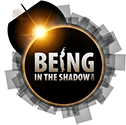This page summarizes independent research projects led and completed by Dr. Kate Russo. Please note this section does not include all projects, and several from the 2024 total solar eclipse remain outstanding. Kate ceased all research activity in early 2025.
Dr. Kate Russo began her eclipse research in 2010, leveraging her expertise in phenomenological research to understand the lived experience and essence of totality. This work provides clarity on how to communicate what it’s like to stand in the Moon’s shadow, shaping her public speaking and media engagements from a psychological perspective. Her research also guides the development of effective eclipse outreach and planning strategies, which she freely shares.
Kate’s research program is rooted in Interpretative Phenomenological Analysis (IPA), a qualitative approach she honed over a decade in health settings. Previously, she served as Assistant Course Director for a doctoral training program in the UK, established an extensive IPA research network, and hosted the National IPA conference. She has peer-reviewed academic journals, examined theses globally, and offers specialist IPA academic mentoring as Australia’s country coordinator. This rigorous approach also informs how she develops evidence-based general guidelines for community eclipse preparations through case studies.
Kate disseminates her independent eclipse research through lectures, workshops, articles, consulting activities, White Papers, and various media platforms. This research is primarily self-funded through her consulting and workshops. See here for an overview of her past solo research projects.
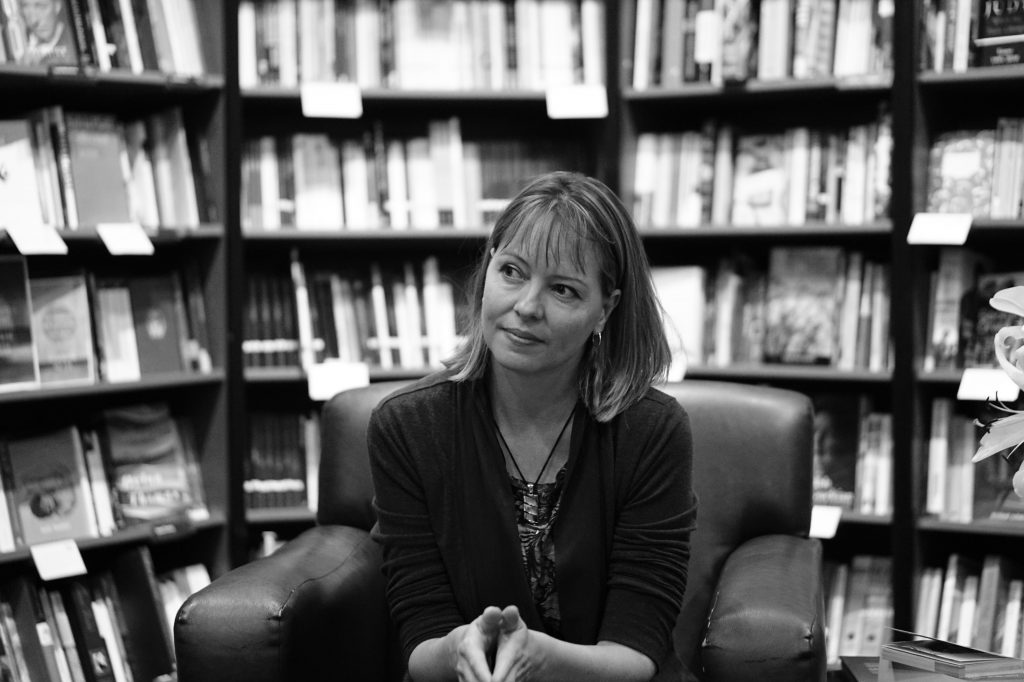
In recent years, Dr. Kate Russo has expanded her focus to include academic research in the fields of awe, niche tourism, and tourism behaviour. This work continues to inform real-world issues and challenges related to eclipses.
Kate occasionally collaborates with other academics and experts to further advance research needs and priorities. Data collection for several research projects occurred during and following the 2024 total solar eclipse, and these projects are in progress. Note that due to health impacts, Kate ceased all research activities in early 2025.
Project Awe: The Pilot Study (2023)
Research Partnership: Professor Andrew Bailey, UC Foundation Professor and SORT Program Coordinator, University of Chattanooga in Tennessee.
Event Location: Annular Solar Eclipse October 14, 2023, Garner State Park, Uvalde County, Texas.
Event Hosts: Visit Uvalde County and the Texas Hill Country River Region, and Garner State Park.
Conference Theme: Solar Eclipse Village – a weekend of eclipse celebrations starting with the Annular Eclipse on the 14th October, followed by a Total Eclipse Showcase on the 15th October. Weekend event coordinated and hosted by Dr. Kate Russo, and included a viewing celebration, presentations, workshops, activities, interactive displays, and contributions by leading solar researchers, national teams, and local schools.
Study Details: As part of the Solar Eclipse Village celebrations, Kate incorporated her Project Awe Pilot Study. Project Awe aimed to capture brainwaves as people observed the total solar eclipse, and this pilot was undertaken during the Annular Eclipse as a practice run and to determine proof of concept. After a study presentation, volunteers were selected to take part and wore a mobile headset for several hours, capturing the duration of the annular eclipse. Immediately after totality, Kate participated in a live science broadcast to share the findings while the study was still in progress, during which preliminary data was shared.
Research Outputs:
Russo, K., & Bailey, A. W. (2024). Deeper Insights into the Solar Eclipse Experience: Piloting Project AWE. Bulletin of the AAS, 56(3). https://doi.org/10.3847/25c2cfeb.530f7677
Russo, K. (2024). Annular Solar Eclipse Day at the Solar Eclipse Village in Uvalde County, Texas: Personal Insights. In Celebrating the Wonder of Science in the Shadow: Special Bulletin of the American Astronomical Society, 56(3). https://doi.org/10.3847/25c2cfeb.fa5dd638



Excerpt from the AAS Press Release – 12 June 2024
Brain Waves and Sound Waves Offer New Insights into the Solar Eclipse Experience
As tens of millions of North Americans saw on April 8th, there is no more beautiful sight in the heavens than the Sun being totally eclipsed by the Moon. Even an annular eclipse like the one that occurred last October 14th, when the Moon blocked all but the Sun’s outer rim to create a dazzling “ring of fire” in the sky, is spectacular enough to attract enthusiasts from around the world. Astronomers often use the word “awesome” to describe such events. But do people genuinely experience awe in response to these cosmic cover-ups? And do you have to actually see a solar eclipse to be moved by it?
Answers to these provocative questions were shared at a press conference today at the American Astronomical Society (AAS) meeting in Madison, Wisconsin.
Measuring Awe
Dr. Kate Russo (Being in the Shadow, Queensland, Australia) is a professional psychologist and enthusiastic eclipse chaser. Combining her vocation and avocation, she’s been studying the human response to solar eclipses for more than a decade. Dr. Andrew Bailey, Professor of Health & Human Performance at the University of Tennessee in Chattanooga, leads UTC’s Brainwave Project, which has shown through electroencephalographic (EEG) research that exposure to nature can mitigate anxiety and have a restorative effect on people. Joining forces in Project AWE, they set out to explore the feasibility of using EEGs to objectively capture people’s physical and emotional reactions to solar eclipses. Russo presented results from a pilot study conducted in Uvalde, Texas, during the October 2023 annular solar eclipse. Under partly cloudy skies, Russo and five volunteers donned headsets equipped with sensors to record electrical activity in parts of the brain known to exhibit spikes or dips in response to stimuli that subjects report as highly engaging, sensory arousing, and strongly positive –– all considered to be indicative of feelings of awe. “Even a cloudy annular eclipse had us completely enthralled,” Russo says, “with pattern shifts in brain wave activity occurring during key moments. Our electroencephalograms objectively captured our frustration and joy as the eclipse progressed, including a period of awe as the clouds parted just before annularity to reveal the ‘ring of fire’ for several minutes. Our work confirms the feasibility of using technology to capture ‘the ineffable’ –– things that are difficult to put into words.”
“Project AWE is the first study to use biometric technology to capture the complex emotion of awe during a solar eclipse,” she continues. “This valuable groundwork paves the way for future investigations into measuring our embodied reactions to other immersive astronomical phenomena, such as total solar eclipses, meteor showers, and the aurora.”
“Capturing neurophysiological states in the field is very novel and important,” adds Bailey. “New technologies and research methods can help us understand the positive impact of awe-inspiring experiences in nature on human perspectives. ”
Click here for the full AAS Press Release, which featured several other eclipse projects presented at the AAS Conference in Wisconson.
AAS special session 124, “First Look at Citizen Science from the 8 April 2024 Total Solar Eclipse”
Can Total Solar Eclipses be harnessed for the Greater Good? (2022)
Organisation: The Adventure Tourism Research Association (ATRA) is a membership organisation which is assembling a worldwide academic community, and helping to facilitate knowledge exchange and the creation of new relationships in the field of outdoor leisure and adventure tourism. ATRA works with local partners to host the annual International Adventure Conference. The association’s website, www.atra.global, is a shared portal for ATRA members’ news.
Conference: 9th International Adventure Conference, 6– 8th December 2022, Queenstown, New Zealand. The 9th International Adventure Conference, postponed from 2020, builds on previous events in Scotland, Norway, England, Ireland and Spain, which attracted global audiences with a diverse range of expertise.
Event Hosts: The conference is being organised in collaboration with the University of Otago, Queenstown Resort College, and Otago Polytechnic Central Campus. Queenstown, home of innovative adventure and nature-based activities, is the ideal place for outdoor researchers, operators and policy makers to converse, share and reflect, as well as offering myriad opportunities to experience nature and adventure. Join us for this unique conference that brings academics and practitioners together to share ideas, foster connections, and extend the ongoing conversation of the International Adventure Conference.
Conference Theme: Flourish: Care for our world and our people. What does it mean for our planet and people to flourish? What do thriving adventure environments, communities and economies look like, and how do we get there? Following themes from the online conference in 2021, how do we ‘think with’ Nature? And, what part might the places, practices and philosophies of adventure play in our flourishing?In support of this theme, presentations will be guided by the 17 Sustainable Development Goals (SDGs) set out by the United Nations. Importantly, these challenging aspirations extend our thinking beyond environmental concerns framed in narrow ideals of pristine protected wildernesses. The goals emphasise human interactions with the planet, nature and one another. The ‘Flourish’ theme of the 9th IAC links to the SDGs by exploring what this concept might mean in practice for destinations, operations, communities, cultures and environments. Flourish is a critical yet positive, forward-looking and hopeful concept – qualities in short supply in current times of burning rainforests, plastic oceanic islands and human inequalities and exploitation. Our hope is that outdoor adventure can play a role in supporting human and non-human flourishing in the 21st century.
Abstracts of 400 to 600 words (excluding references) are invited for peer review. Abstracts should clearly state the presentation objectives and findings, and explicitly identify how these findings advance our knowledge of flourishing via or in outdoor adventure. Please identify the specific SDG(s) that your work addresses.



Submitted Abstract for Presentation
We all know that moments in nature enable us to experience awe. Awe is a complex emotion that is difficult to research, but is commonly understood to require a sense of vastness, and the need to change how we think about ourselves and the world (Keltner & Haidt). Perlin & Li (2020) reviewed several studies showing that laboratory-induced awe can result in altruistic and prosocial behaviors, seemingly by reducing the sense of individual self.
One of the most awe-inspiring nature events is a total solar eclipse. This occurs when the Moon moves between the Earth and Sun, casting a dark shadow on those within a narrow path of totality. A total solar eclipse is visible somewhere around the world on average every 18 months, with only those located within the path able to experience the full experience – totality.
There is no doubt that experiencing totality induces much more complex emotional responses than what can ever be elicited in a lab. People are reduced to tears, and are unable to put into words the immensity of the emotions they feel. Totality is clearly a profound event for those who witness it, and has been recorded throughout history as eliciting fear, terror and wonder in equal measures. Many cultural interpretations have been offered, with some cultures believing the totally-eclipsed Sun was an omen of doom; a sign of the Sun being consumed by a being; or alternatively, a representation of unity and a time of fertility to come.
Today, we understand the celestial mechanics and coincidence of scale that produce this spectacular event. Yet this scientific understanding still does not replace our intense human response during totality. Detailed research has shown this fully immersive and transformative event triggers primal fear, immense awe, feelings of insignificance, and connection to something greater, whilst also altering our sense of time, place and person, and ending in a strong desire to repeat the experience (Russo, 2012).
Some who experience totality for the first time feel their life’s purpose has changed, and they spend their lives intersecting the Moon’s shadow wherever it may be cast on the surface of the Earth. I am one of these people–having experienced my first total solar eclipse in 1999–and I will continue to chase total eclipses for the rest of my life. This is more than an adventure travel goal or hobby, it is fully embedded within me and a way of life.
Of specific interest are the feelings of connection during totality that are widely reported. Following the total solar eclipse in 2017, twitter messages from those who had experienced totality used more connected language compared to those who remained outside of the path of totality (Goldy, Jones & Piff, 2022). Large-scale collective language shifts on social media following totality suggest the potential for positive impacts that go beyond the individual, and open up interesting questions regarding the future role of niche adventure travel.
This presentation will share the results of a study aimed to elicit the complex feelings in those who had witnessed a total solar eclipse in the previous 24 hours. 15 people were asked to talk freely on video about their experience as it related to feelings of insignificance and connection. Interpretative Phenomenological Analysis (IPA) was used to interpret the responses, analysed in a case study series.
The results allow us to understand how a total solar eclipse can allow us to flourish–not only as individuals, but collectively for the greater good.
References
Russo, 2012. Total Addiction: The Life of an Eclipse Chaser. Springer: Berlin.
Keltner, D. J., & Haidt, J. (2003). Approaching awe, a moral, spiritual, and aesthetic emotion. Cognition and Emotion, 17(2), 297–314. https://doi.org/10.1080/02699930302297
Goldy, S.P., Jones, N.M., & Piff, P.K. (2022). The Social Effects of an Awesome Solar Eclipse. Psychological Science, Aug, p1-11. http://dx.doi.org/10.1177/09567976221085501
Perlin, J. D., & Li, L. (2020). Why does awe have prosocial effects? New perspectives on awe and the small self. Perspectives on Psychological Science, 15(2), 291–308. https://doi.org/10.1177/1745691619886006
Other Completed Research Projects
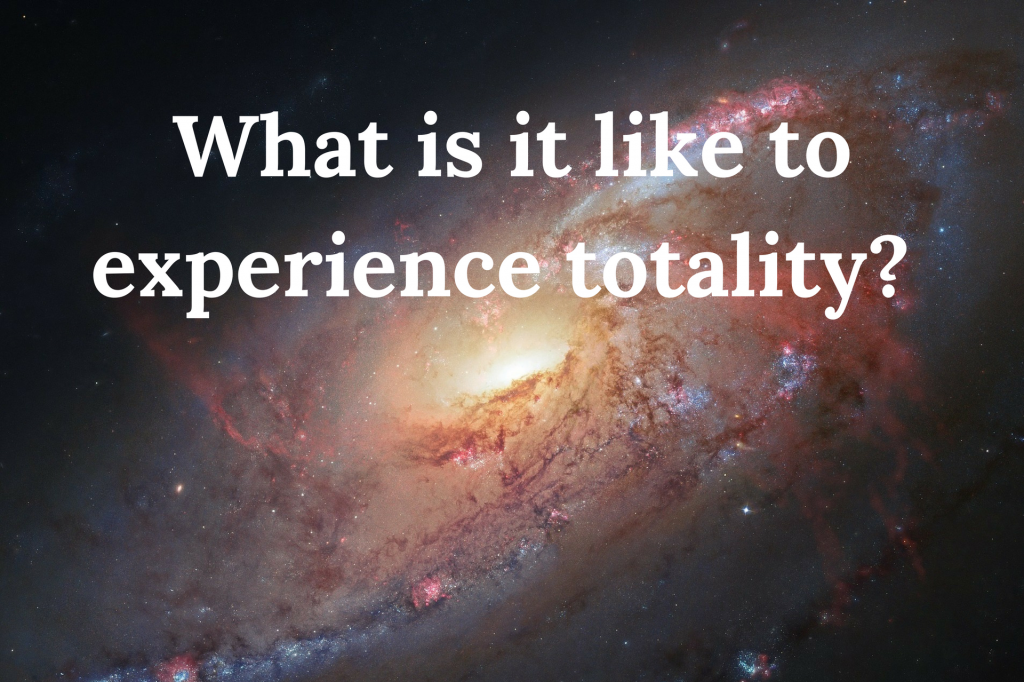
What is it like to experience totality
Status: Survey and interviews completed in 2011.
Dissemination: Published in 2012 in Total Addiction: The Life of an Eclipse Chaser; presentation at many lectures and events, extensively in the media
This project aimed to answer the question that everyone wants to know – what does it feel like during totality? This sounds like a simple question to answer, but it is not for many reasons. Firstly, the totality experience is often completely overwhelming, so we are not able to easily make sense of it. Secondly, there are not the words to describe what it is like. And finally, we are expected to answer this question in a neat soundbite. Impossible!!
I chose to survey eclipse chasers for this project. Eclipse chasers are more likely to be able to make sense of totality by virtue of repeated experience. Using surveys allowed for a collation of common experiences to be identified, and in-depth interviews allowed full exploration of the experience.
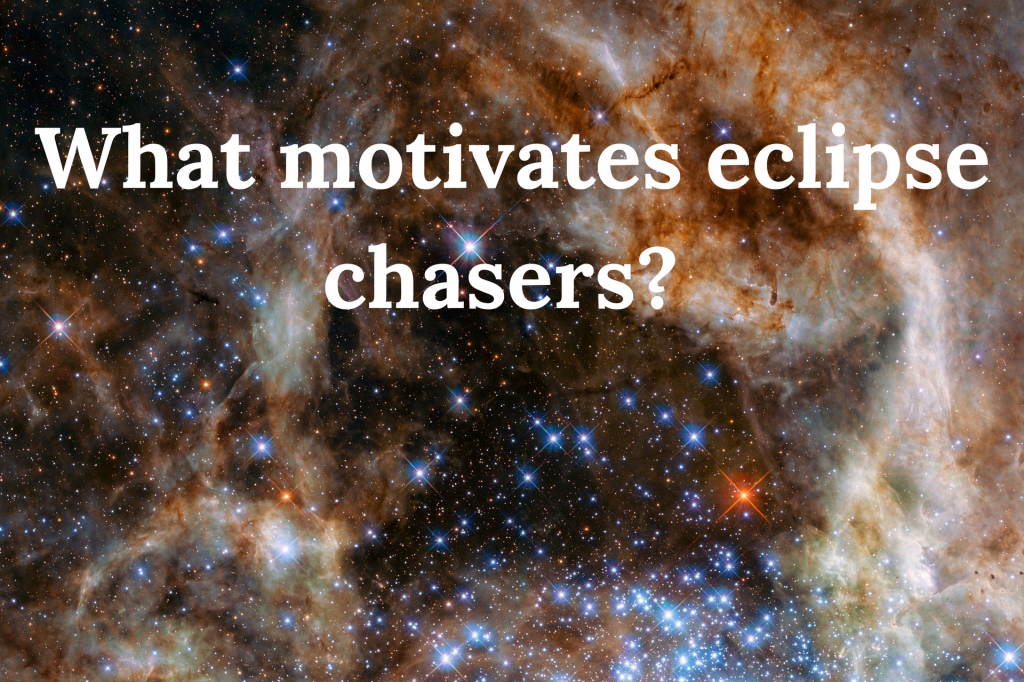
What motivates eclipse chasers?
Status: Interviews completed in 2011.
Dissemination: Published in 2012 Total Addiction: The Life of an Eclipse Chaser using nine case examples; presentation at many events.
For some people, seeing a total solar eclipse seems to ignite a never-ending source of motivation that sees them through a lifetime. Having felt this myself, I was curious – where does that passion come from, and why is it so strong that it seems to overtake our plans and become a way of life?
I was able to identify how every eclipse is different, ensuring there was novelty every time and avoiding habituation that often occurs with repeated exposure to an exciting event. Also, most eclipse chasers were developing a sense of mastery over some aspect of their eclipse chasing or using their existing skills to help others. Psychological research has shown that these factors are strong drivers, and also contribute to a meaningful life.
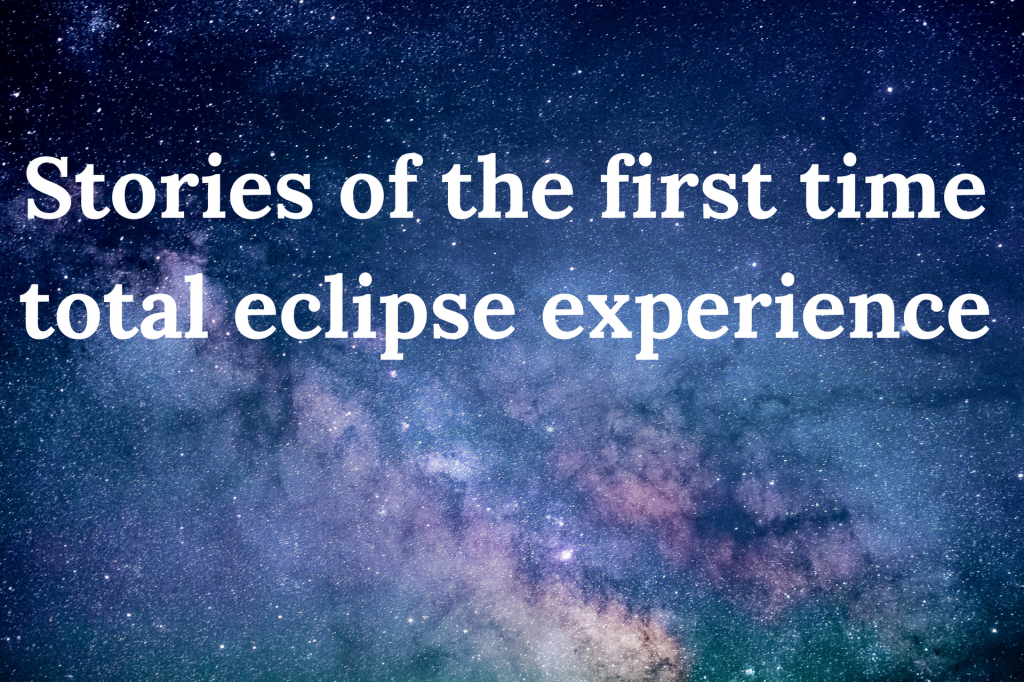
Stories of the First-time Total Eclipse Experience
Status: Interviews completed in 2012, the project completed 2017.
Dissemination: Publication of stories in book 2 Totality, and book 3 Being in the Shadow, plus various presentations.
In 2012, I went home to Far North Queensland to research the first time eclipse experience for a number of people. I used local media to recruit local participants, who then completed a survey before and after the eclipse. This research shows that many people do not think the total eclipse will be interesting, assuming it is no different to a partial eclipse. However, afterwards, they wonder why they were not informed of how amazing it is!
Shorter stories can be read in my second book Totality: the Total Solar Eclipse of 2012 in Far North Queensland. More detailed stories of six individuals who were most clearly able to describe their experiences in a rich and detailed way are published in Being in the Shadow.
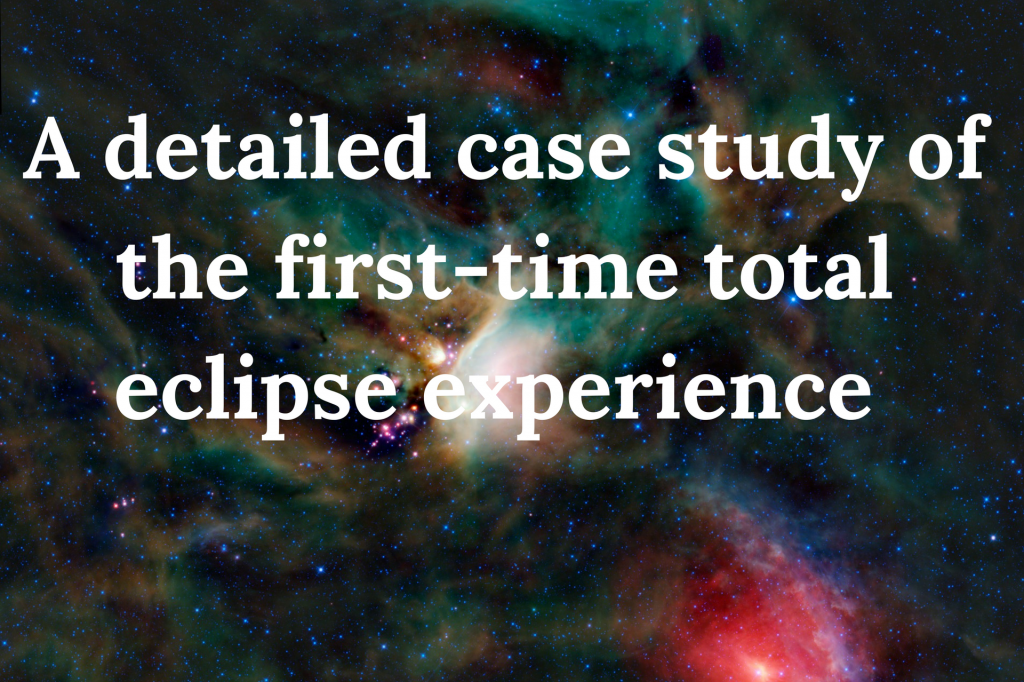
A detailed case study of the first time eclipse experience – “The moment I lost my mind”.
Status: Interview completed 2012; case study presented in 2015.
Dissemination: Abstract submitted and presentation at International Adventure Travel Conference at Sheffield Hallam University in 2015; case study also presented as part of a many public lectures leading up to 2017.
Following the total eclipse of 2012 in my home region, I interviewed many locals and visitors about their first-time eclipse experience. The account given by Wayne was especially detailed and powerful. This very detailed and emotive case study is a powerful way to demonstrate how an ordinary person living in the path of totality can be impacted by their first time total eclipse experience. This case study explores Wayne’s expectations, the eclipse experience, and the impact that it had upon his life, using Interpretative Phenomenological Analysis to capture the key themes.
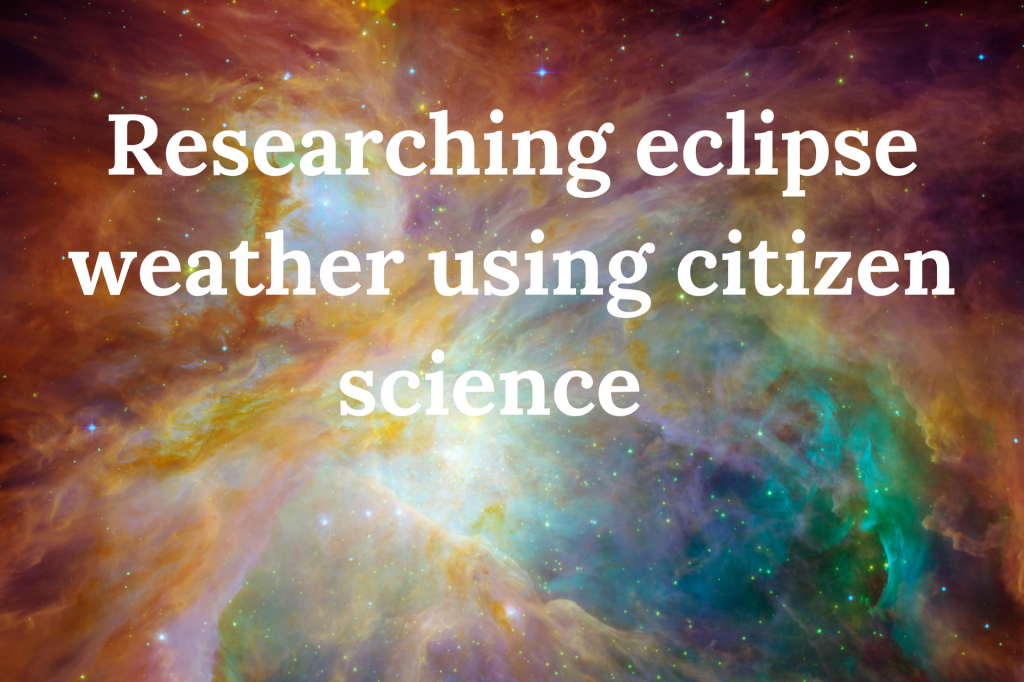
Researching eclipse weather using citizen science
Status: Citizen science input completed in 2014
Dissemination: Published in the December 2014 edition of The Journal of the Royal Astronomical Society of Canada.
One of the concerns about the 2015 total eclipse in the Faroe Islands was the unsettled weather in March. Using historical data for eclipse weather predictions was problematic, as the data was averaged across the day from only one location.
Dr Geoff Sims – a fellow eclipse chaser – led a citizen science project to capture weather data at eclipse time in March, the year before the eclipse. Citizens were asked to take photos of the Sun at the same time every day for a month. The observations were then compared to the predicted weather at each location to determine forecasting accuracy. We can explore historical climate patterns, but as the saying goes, climate is what we expect, and the weather is what we get.
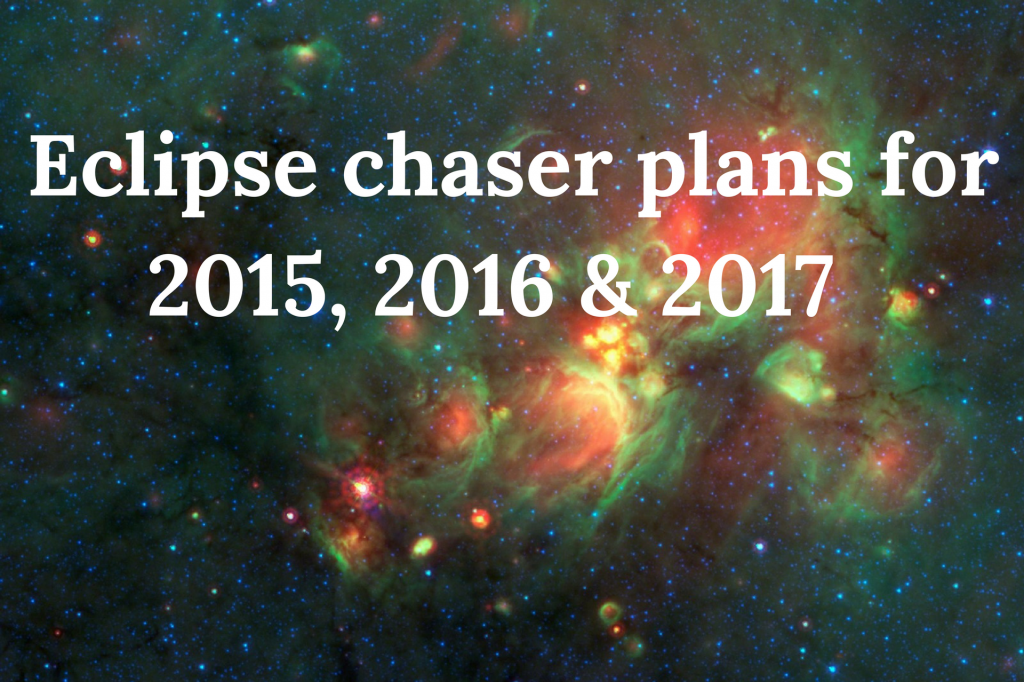
Eclipse chaser plans for the next three total eclipses
Status: Survey completed in early 2014.
Dissemination: Results presented at the Nordic Eclipse Conference in March 2014 in the Faroe Islands.
In early 2014, I undertook a brief survey of eclipse chasers to explore what their plans were for the next three total solar eclipses – 2015, 2016, and 2017. The response rate was quite low at 10%, so these results are not generalizable.
For those who did respond, this survey indicated that 60% were definitely planning to travel to the 2015 total eclipse in the Arctic region; 41% to the 2016 eclipse in Indonesia, and a whopping 94% to the U.S. eclipse in 2017. The main barriers for deciding not to travel were weather and cost.
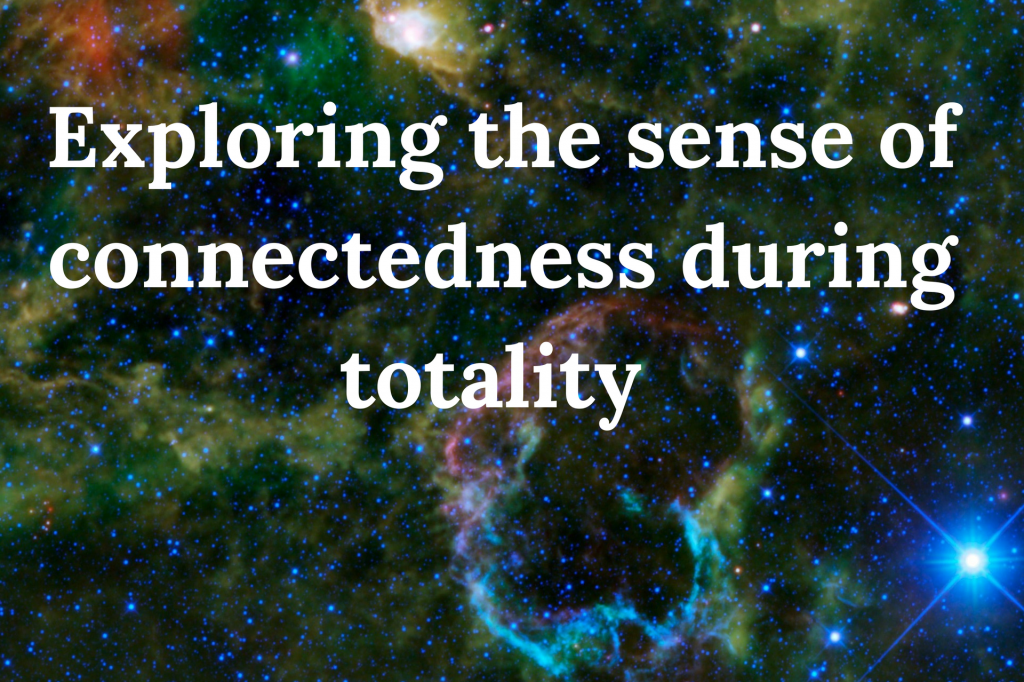
Exploring the sense of connectedness during totality
Status: Data collection completed in 2016
Dissemination: Videos used in many presentations; materials used to inform media reports; content used to inform 2022 research project.
Immediately after the 2016 total eclipse, I ran a post-eclipse workshop at the Sulawesi Eclipse Festival in Palu, Indonesia. In this workshop, we shared our personal experiences of the wonderfully clear and emotive total eclipse. There were tears, there was gratitude, there was a great feeling of being at one in the world. It was pretty special.
Participants then recorded individual experiences on camera, describing what totality was like; and exploring their lived experience of connection. These interviews have helped to describe ‘the ineffable’.
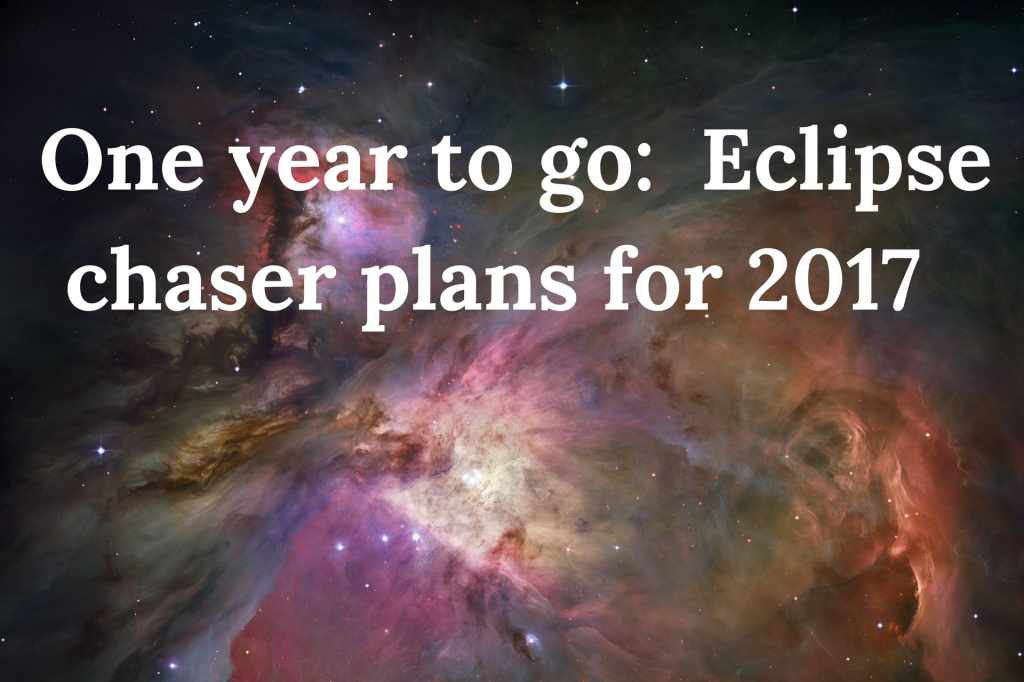
One year to go – Eclipse chaser plans for 2017
Status: Survey completed in August 2016.
Dissemination: Results used in ongoing consultations with eclipse coordinators for planning; also in presentations.
In August 2016, one year before the total eclipse, I surveyed eclipse chasers about their plans for 2017. The response rate was around 27% of the group sampled. 54% had made all their plans one year before the eclipse.
95% were selecting their viewing location based upon historical weather data. Only 3% felt going to the point of greatest duration was important. The majority of respondents – a huge 84% – were heading towards the first four states, because of more favourable weather- Oregon, Idaho, Wyoming and Nebraska. 79% felt it was important to be near the centre-line and three-quarters of those surveyed felt mobility on the day was important. The many insights from this data have been used to inform community planning.
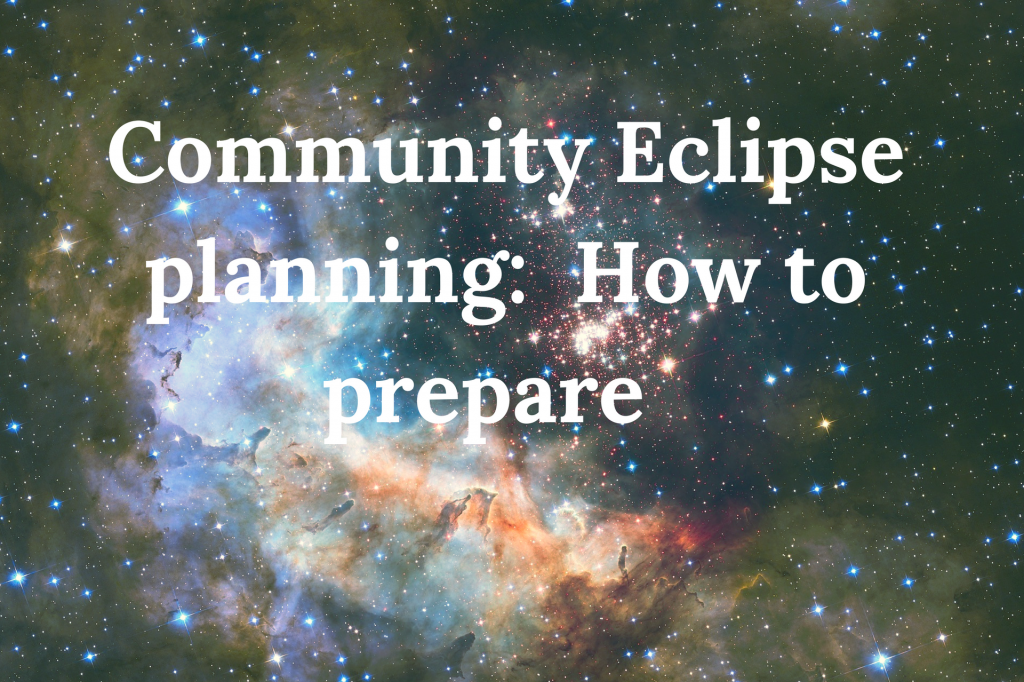
Community Eclipse Planning – how to prepare
Status: Interviews completed in 2012, and 2015.
Dissemination: White Paper on Community Eclipse Planning, launched at the Portland AAS meeting 2015; disseminated to eclipse coordinators across the US in 2015, downloadable from my website; Information used in consultation sessions.
In 2012, while undertaking research interviews before the eclipse, I identified that the local community was not engaged in eclipse planning, and perceived the eclipse plans were purely for tourists coming in. I undertook community engagement activities, which addressed this gap and afterwards interviewed eclipse coordinators exploring hindsight lessons. I applied what I learned in my role as Eclipse Consultant in 2015 in the Faroe Islands, and again afterwards, engaged in interviews to identify key learning points about planning. The White Paper is aimed at communities within the path and highlights the need to start planning early, and to engage stakeholders and the community to ensure the eclipse has a lasting legacy in the region.
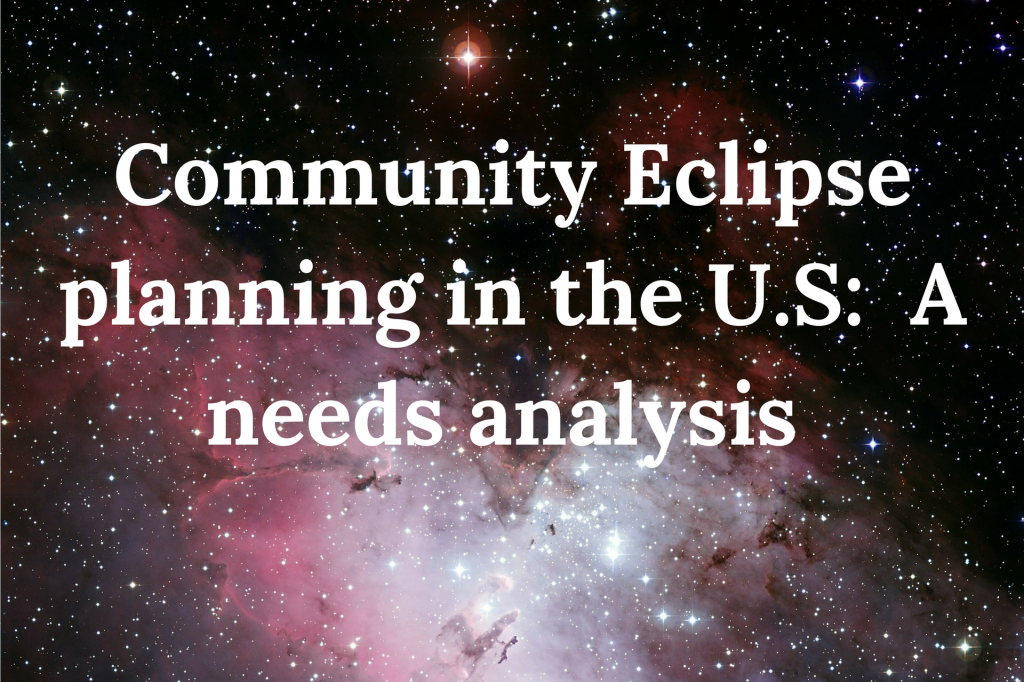
Community Eclipse Planning in the US: A needs analysis
Status: Needs analysis completed in Jan 2017
Dissemination: Results extensively drawn upon to inform advice in consultations with eclipse coordinators for planning; included in White Paper on Community Eclipse Planning; and in presentations.
Over a thousand communities fell within the path of totality for the 2017 total solar eclipse. As there had not been a total solar eclipse in the U.S. since 1979, this was unknown territory for many communities. I undertook a needs analysis of 31 communities across 10 states along the path of totality. This information informed community eclipse planning consultations, advice, and development of the updated White Paper in Community Eclipse Planning. I had planned a detailed tour of the path of totality to visit these regions, delivering what was needed, however, this did not occur due to changes in US visa requirements.
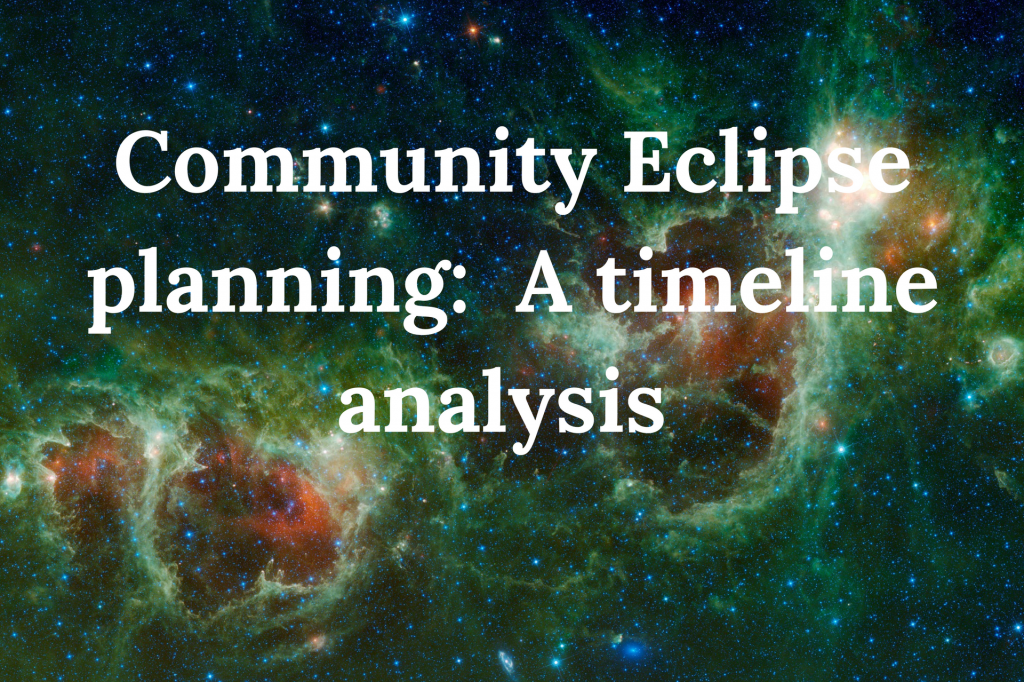
Community Eclipse Planning – timeline analysis
Status: Interviews at key time points in the year before totality 2017 – data collection completed
Dissemination: Information used in consultation sessions;
workshops, and to update White Paper to the 2nd Edition
The White Paper in Community Eclipse Planning was an important guidance document for communities preparing for a total solar eclipse. However, it did not indicate a time frame for required activities. For this project, I undertook interviews with eclipse coordinators at different time points in the planning process – 12 months to go, 9 months, 6 months and 3 months, and 1 month; as well as following the eclipse. This information provides a useful and detailed framework for future planning, stressing the need for starting early, and highlighting key tasks at different points of time.
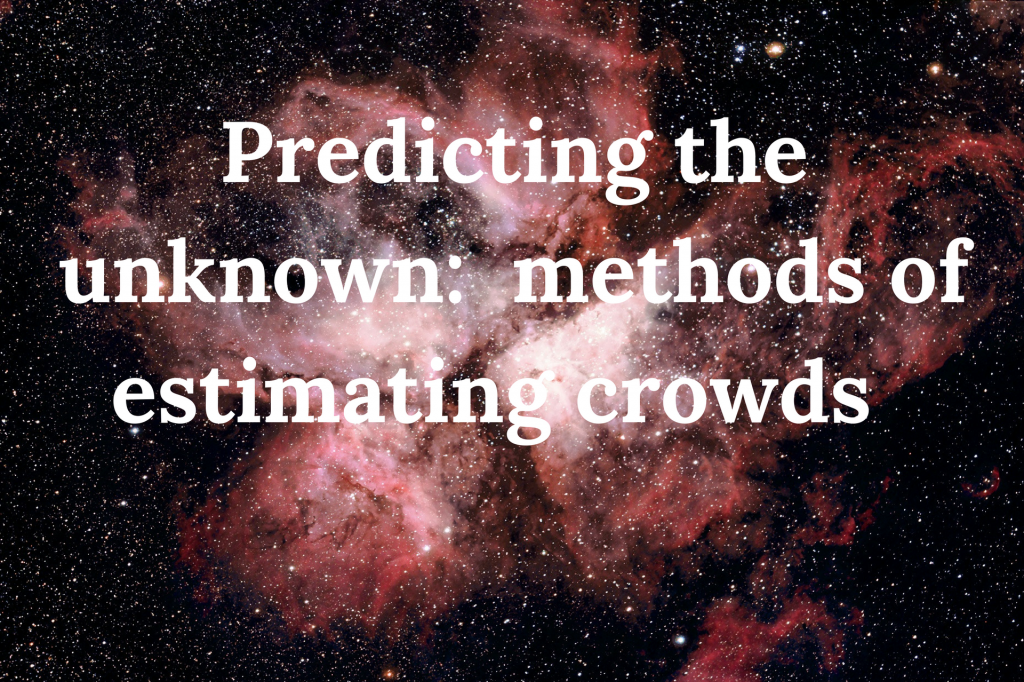
Predicting the unknown: how to accurately predict numbers for your region
Status: Pre-eclipse and post-eclipse interviews from 2017 TSE completed
Dissemination: Information used in consultations with eclipse coordinators; presentations, workshops, and in consultation work with individual locations.
When planning for a total eclipse, one of the key unknowns is how many will travel to your location. I worked with many communities along the path for 2017 helping to estimate the numbers expected. Important factors were located along the path, road networks, general tourist appeal, weather predictions, past community events, and marketing infrastructure. Several methods were suggested. Following the eclipse, interviews were then repeated to determine the accuracy of predictions, giving confidence in methods to use for future eclipses. One key finding is that predictions MUST be tailored to each location and cannot be estimated based on other eclipse paths.
